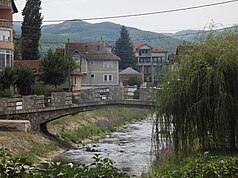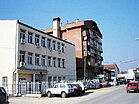Viti, Kosovo
Viti
| |
|---|---|
Town and municipality | |
| Coordinates: 42°18′N 21°23′E / 42.300°N 21.383°E | |
| Country | Kosovo |
| District | Gjilan |
| Government | |
| • Mayor | Sokol Haliti |
| Area | |
• Municipality | 269.69 km2 (104.13 sq mi) |
| • Rank | 23rd in Kosovo |
| Elevation | 499 m (1,637 ft) |
| Population (2011) | |
• Municipality | 46,987 |
| • Density | 170/km2 (450/sq mi) |
| • Urban | 4,924 |
| Demonym(s) | Albanian: Vitias (m), Vitiase (f) |
| Time zone | UTC+1 (CET) |
| • Summer (DST) | UTC+2 (CEST) |
| Postal code | 61000 |
| Area code | +383 38 |
| Vehicle registration | 06 |
| Website | kk |
Viti (Albanian definite form: Vitia) or Vitina (Serbian Cyrillic: Витина) is a town and municipality located in the District of Gjilan in Kosovo. According to the 2011 census, the town of Viti has 4,924 inhabitants, while the municipality has 46,987 inhabitants.
Geography
[edit]The town of Viti and the southern part of the Municipality lies on the foothills of the Skopska Crna Gora Mountains.[1]
History
[edit]Ottoman period
[edit]The municipality has several settlements historically inhabited by the Laramans, crypto-Catholics.
Kosovo War and aftermath
[edit]During the Kosovo War 16 KLA soldiers, as well as 5 Serb soldiers and policemen were killed in Viti.[2] The entire fighting happened in 1999 and in the southern part of the municipality, near the Karadak Mountains, in villages such as Lubishtë, Gjylekare, Mogillë, Smirë, Kabash and Dëbëlldeh.[2]

During and after the Kosovo War 76 civilians were killed, 38 Albanians and 38 Serbs.[2]

Following the 1999 Kosovo War, it was the home of A Company, 2/505 Parachute Infantry Regiment, 82nd Airborne Division, the first KFOR troops to begin stabilization efforts in the municipality. After the initial unit left, Viti was the site of a subsequent international scandal when a Staff Sgt. Frank J. Ronghi, from A company, 3/504 Parachute Infantry Regiment raped and killed a local girl. The subsequent investigation uncovered serious training and leadership deficiencies in the 3/504 Parachute Infantry Regiment, and catalysed a tremendous change in the training of units deploying for peacekeeping operations.[3] The Church of the Holy Mother of God, Podgorce was looted during the conflict.
During the NATO bombing of Yugoslavia, the Orthodox cemetery in Viti and the village of Dobreš were hit by missiles.[4]
In August 2003, explosive devices planted in Klokot destroyed five Serb houses, with several injuries, including two American KFOR soldiers.[5]
Serbian Orthodox cemeteries have been destroyed in Viti, among other towns, and in 2004 during unrest, nuns of the Binča monastery were physically attacked, by ethnic Albanians.[6]
Insurgency in the Preševo Valley
[edit]During the Insurgency in the Preševo Valley, the UÇPMB mostly recruited fighters from the Karadak region of Kosovo, specifically in the town of Vitia. In February 2001, many towns and villages in the region were covered with posters that instructed Albanians between the ages of 18 and 48 to join their fellow Albanians in the UÇPMB. These posters were supposedly issued by the previously disbanded KLA.[7]
Insurgency in Macedonia
[edit]Amidst the Insurgency in Macedonia, approximately 300 NLA fighters from the Vitia municipality, mostly recruited in Dëbëlldeh and Mjakë, participated in several battles against Macedonian security forces in Tanuševci.[8] The NLA also used Dëbëlldeh and Mjakë as strongholds, where they would store Arms.[9][10]
Contemporary
[edit]In 2013 in response to a KLA monument being removed by Serbian authorities in Preševo, a Kosovo Albanian crowd in Viti demolished a Yugoslav-era memorial for anti-fascist Partisans that were killed during the Second World War.[11]
Municipality
[edit]
- Ballancë
- Beguncë
- Binça
- Budrikë e Epërme
- Buzovik
- Çifllak
- Dëbëlldeh
- Devajë
- Drobesh
- Gërmovë
- Gjylekar
- Goden i Madh
- Gushicë
- Kabash
- Letnicë
- Lubishtë
- Mjak
- Novosellë
- Podgorc
- Pozharan
- Radivojc
- Ramjan
- Ramnishtë
- Remnik
- Sadovinë e Çerkezëve
- Sadovinë e Jerlive
- Shasharë
- Sllatinë e Epërme
- Sllatinë e Poshtme
- Smirë
- Stubëll e Epërme
- Stubëll e Poshtme
- Tërpezë
- Tërstenik
- Vërban
- Vërnakollë
- Vërnez
- Zhiti
Demographics
[edit]| Year | Pop. | ±% p.a. |
|---|---|---|
| 1961 | 33,642 | — |
| 1971 | 39,780 | +1.69% |
| 1981 | 47,839 | +1.86% |
| 1991 | 57,290 | +1.82% |
| 2011 | 46,987 | −0.99% |
According to the last official census done in 2011, the municipality of Viti has 46,987 inhabitants. Based on the population estimates from the Kosovo Agency of Statistics in 2016, the municipality has 47,370 inhabitants.
Ethnic groups
[edit]The ethnic composition of the municipality:
| Ethnic Composition, Including IDPs | |||||||||||||
| Year/Population | Albanian | % | Serbs | % | Croats | % | Roma | % | Total | ||||
|---|---|---|---|---|---|---|---|---|---|---|---|---|---|
| 1961 | 20,496 | 60.92 | 10,442 | 31.04 | 2,077 | 6.17 | 21 | 33,642 | |||||
| 1971 | 26,927 | 67.69 | 9,649 | 24.26 | 2,613 | 6.57 | 126 | 0.32 | 39,780 | ||||
| 1981 | 35,105 | 73.38 | 8,369 | 17.49 | 3,722 | 7.78 | 229 | 0.49 | 47,839 | ||||
| 1991 | 45,078 | 78.68 | 7,002 | 12.22 | 4,331 | 7.56 | 373 | 0.65 | 57,290 | ||||
| 2011 | 46,669 | 99.3 | 113 | 0.24 | 70 | 0.1 | 26 | 46,987 | |||||
| Reference: Yugoslav population census data, and the 2011 census in Kosovo. | |||||||||||||
Maps
[edit]Ethnic and Religious Affiliation in the Municipality according to the 2011 census results recorded in Kosovo.[12] Tribal Affiliation of Albanians according to the book Gornja Morava i Izmornik.[13]
-
Ethnic Affiliation in the Vitia Municipality
-
Religious Affiliation in the Vitia Municipality
-
Tribal Affiliation in the Vitia Municipality
Notable People
[edit]- Rashit Mustafa, from Lubishtë, commander of the KLA.
- Njazi Azemi, from Mogillë, commander of the KLA and LAPMB.
- Jonuz Zejnullahu, from Skifteraj, Imam and commander of the KLA.
- Shemsi Beqiri, from Viti, Kickboxing World Champion.
- Muharrem Sahiti, from Budrikë, football coach.
- Imri Demelezi,[14] from Sllatine e Poshtme, Deputy Minister of Agriculture, Forestry and Rural Development
- Salih Salihu, Deputy in Kosovan Parliament
- Visar Ymeri, from Viti, politician.
- Sinan Hasani, from Pozheran, President of Yugoslavia
- Marko Sopi, from Binač, Catholic prelate.
- Bastien Toma, footballer
- Betim Halimi, footballer
- Liridon Krasniqi, footballer
- Milaim Rama, footballer
- Urata Rama, sports shooter
See also
[edit]References
[edit]- ^ Warrander, Gail; Knaus, Verena (2010). Kosovo: The Bradt Travel Guide. Bradt Travel Guides. ISBN 978-1-84162-331-3.
- ^ a b c "List of killed, missing and disappeared 1998-2000".
- ^ Cohen, Roger (2 August 2000). "U.S. Sergeant Gets Life in Murder of Kosovo Girl, 11". The New York Times. ISSN 0362-4331. Retrieved 4 April 2023.
- ^ Civilian Deaths in the NATO Air Campaign. Human Rights Watch. 2000. p. 59.
- ^ Serbian Studies. Vol. 18. North American Society for Serbian Studies. 2004. p. 315.
- ^ Savo B. Jović (2007). Ethnic Cleansing and Cultural Genocide on Kosovo and Metohija: Testimony to the Suffering of the Serbian Orthodox Church and Serbian People from 1945 to 2005. Holy Synod of Bishops of The Serbian Orthodox Church. pp. 113, 157. ISBN 978-86-7758-017-9.
- ^ Neumann, Friedrich. "Wag the Dog: The Mobilization and Demobilization of the Kosovo Liberation Army" (PDF). Retrieved 2 March 2023.
- ^ "List of terrorists and members of organized criminal organizations in Kosovo and Metohija". sorryserbia.com. Retrieved 7 March 2023.
- ^ RATHFELDER, ERICH (10 March 2001). "Über die Grenze und in die Berge". Die Tageszeitung: taz (in German). p. 4. ISSN 0931-9085. Retrieved 31 July 2022.
- ^ Rathfelder, Erich (22 October 2012). Kosovo: Geschichte eines Konflikts (in German). Suhrkamp Verlag. ISBN 978-3-518-79620-7.
- ^ Ristic, Marija; Peci, Edona (22 January 2013). "UN Seeks Calm After Serbia Monument Protest". Balkaninsight. Retrieved 6 September 2016.
- ^ "Agjencia e Statistikave të Kosovës". Esk.rks-gov.net. Archived from the original on 2 November 2013. Retrieved 29 August 2017.
- ^ Urošević, Atanasije (1931). Gornja Morava i Izmornik: antropogeografska ispitivanja. Narodna Štamparija.
- ^ "Imri Demelezi - Deputy Ministers". Ministry of Agriculture, Forestry and Rural Development. Retrieved 13 September 2023.











